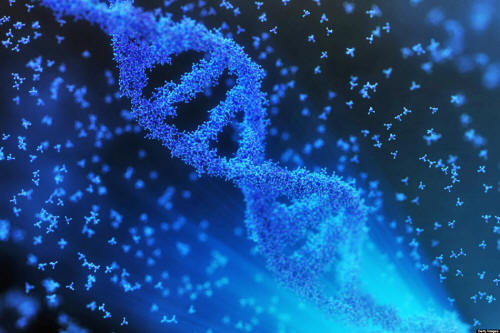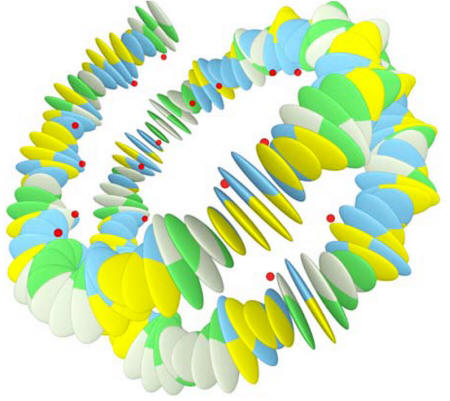|
June 09, 2016 from Collective-Evolution Website
Our capabilities in particular have yet to be studied in-depth by the mainstream scientific community.
Yet the study of phenomena like the
placebo effect, distant healing, telepathy, and the physical impacts
of human intention, not to mention the Mind-Body connection, has
yielded statistically significant results which have been available
in 'reputable peer reviewed journals' for decades.
Well, there are many codes in our DNA that scientists have yet to crack. Parts of our DNA, for example have no known biological function, or at least we have yet to discover them. Maybe they have spiritual applications, or are connected to the non-physical realm in some way.
These seemingly useless DNA are referred to as 'Junk DNA,' or 'non-coding DNA.'
But we are learning more about them each
day, as
Scientific American reports, so the label isn't entirely
accurate.
And our knowledge of DNA has just
changed again, as physicists have confirmed that there is a second
layer of information hidden in our DNA, meaning that there is more
than one way that DNA mutations can affect us.
For example, there is a code for a protein that will make your skin brown, or your eyes dark, etc.
All of this is determined by the way DNA
is folded. Since the DNA in our body is extremely long, spanning a
length of up to two meters, it has to be wrapped and folded in a
certain way to fit inside of our bodies.
Even the way we think and perceive the
environment, how feel, and what we believe can shape our DNA. Some of these mechanical cues have been identified by a group of scientists at Leiden University in the Netherlands.
Led by Helmut Schiessel, they were, as Science Alert explains,
The discovery suggests that one day, we may be able to manipulate the mechanisms that determine the way DNA is folded in order to hide certain genes that produce deadly disease.
Read the study, Multiplexing Genetic and Nucleosome Positioning Codes - A Computational Approach.
Is the Genetic 'Tweaking' of Humans on Its Way/Already Here?
Genetic manipulation is already occurring, and in fact we recently published an article about the first human being to have their DNA manipulated to make their white blood cells 20 years younger (you can read more about that here).
And all my research into black budget programs suggests that human genetic engineering is already happening to further militaristic agendas.
The evidence for the existence of multiple super soldier programs and other, equally frightening projects is compelling, but that's a discussion for another article, as is the black budget topic that's linked above.
Today, it's hard to know what's real and what's not, and it's unfortunate that it takes a mainstream media outlet to acknowledge something before the masses consider it to be real. That's a tremendous amount of power to hold, and we know the media has been corrupted by financial, corporate and other elitist agendas.
It really is fascinating to imagine what we may be capable of. Perhaps one day we will eradicate all disease by learning how to manipulate our genetics, turning certain genes on and others off, even discovering new ones.
What if there is already an intelligent extraterrestrial civilization out there somewhere in the universe which has learned to tweak their DNA so they can live for hundreds of years?
The future of genetic manipulation holds endless possibilities, and while many people worry about the consequences of us playing God, I argue that perhaps these types of discoveries were just waiting there for us to stumble upon, and our natural progression toward these discoveries was all part of 'the plan,' if there is one.
Perhaps we create it ourselves.
One thing is for certain though - as with any new discovery, it does not matter what we find or what technology we develop, it's the consciousness and intention behind how we use this knowledge that matters.
Our history of innovation has been consistently marred by violence and the misuse of power, so I can only hope we are approaching a more peaceful era at this stage of our development.
More information at below report...
by Erik Arends
from
PHYS
Website
The rigid base-pair model is forced, using 28 constraints (indicated by red spheres), into a lefthanded superhelical path that mimics the DNA conformation in the nucleosome.
Credit: Leiden
Institute of Physics
Helmut Schiessel and his group
simulated many DNA sequences and found a correlation between
mechanical cues and the way DNA is folded. They have published their
results (Multiplexing Genetic and Nucleosome
Positioning Codes - A Computational Approach) in PLoS
One.
If you have brown eyes, for example, this is because a series of letters in your DNA encodes for proteins that build brown eyes. Each cell contains the exact same letter sequence, and yet every organ behaves differently.
How is this possible?
Each of our cells contains two meters of DNA molecules, and these molecules need to be wrapped up tightly to fit inside a single cell. The way in which DNA is folded determines how the letters are read out, and therefore which proteins are actually made.
In each organ, only relevant parts of the genetic information are read.
The theory suggests that mechanical cues
within the DNA structures determine how preferentially DNA folds.
With their computer code, they have simulated the folding of DNA strands with randomly assigned mechanical cues. It turns out that these cues indeed determine how the DNA molecule is folded into so-called nucleosomes.
Schiessel found correlations between the mechanics and the actual folding structure in the genome of two organisms—baker's yeast and fission yeast.
This finding reveals evolutionary changes in DNA - mutations - that have two very different effects:
|



